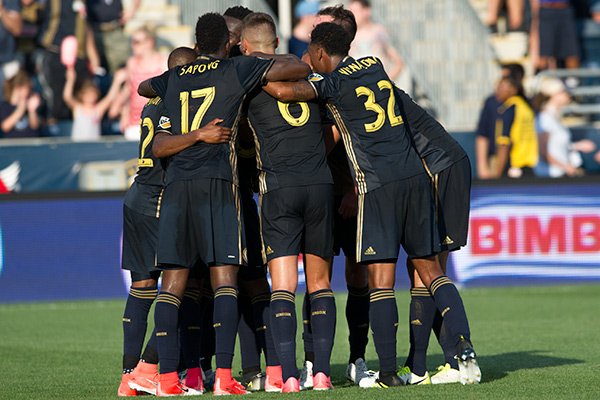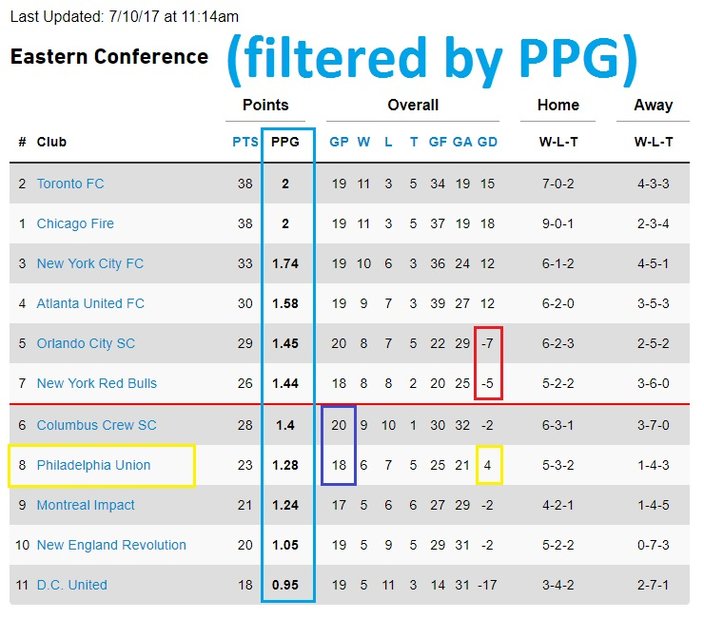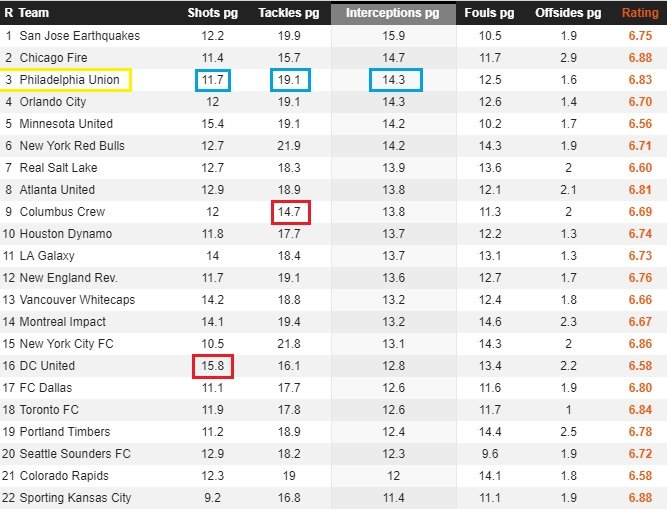
July 10, 2017
 Earl Gardner/Philly Soccer Page
Earl Gardner/Philly Soccer Page
Teammates swarm Roland Alberg after the midfielder's 25-yard goal in the 3-0 win against New England.
Shortly after the Philadelphia Union's 3-0 victory against the New England Revolution last Sunday, MLSSoccer.com's "Armchair Analyst" Matt Doyle asked a simple poll question about the winners on Twitter:
Are they good?
Sixty-eight percent of the 1,360 responders said "no." That sampling of the greater MLS community wasn't impressed with the Union despite the club compiling the league's fourth-best record since the end of April.
Since the end of April the Union have the 4th-best record in @MLS. Are they good?
— Matthew Doyle (@MattDoyle76) July 2, 2017
It started with the 3-3 home draw against Montreal, a game in which the Union blew a three-goal lead but ironically snapped a four-game losing streak anyway. It kicked off a six-game unbeaten run that featured another draw and four straight wins, pulling the Union out of the Eastern Conference basement, but only temporarily.
Philly went right back to the bottom with a three-game losing streak, only to rip off two more wins and a draw to enter the Gold Cup break as the eighth-best conference team with six wins, seven losses, and five draws.
Jim Curtin's club is five points out of the wild card spot currently held by Columbus. The Union and Crew actually play twice in the span of five days later this month, so quirky MLS scheduling gives us a pivotal home-and-home series between the two teams before we even hit August.
By standings alone, a neutral fan probably wouldn't think too much of the Union.
Going by the more important points-per-game column, Philly is 14th in the overall standings and 8th in the east. Tweaking the parameters with PPG puts Red Bull in the playoffs with Columbus in seventh, due to the fact that they've already played 20 games this season. The Union have two games in hand on the Crew, which should be a big advantage heading into that late July series.
Another thing to look at in the standings is the goal differential column, where the Union sit +4 on the season by virtue of seven clean sheets. They're one of just five conference teams with a positive goal differential, while Orlando occupies fifth place with a -7 margin. Philadelphia's 21 goals conceded is third-best in the East, behind first- and second- place Chicago and Toronto.
You see that Philly has better margins than Orlando and Red Bull, despite going 1-2 against both clubs through the first half of the schedule.
There's also the typical conference imbalance, but it's reversed in 2017.
For the first time in a long time, the East looks stronger than the West, with Los Angeles, Seattle, RSL, and Colorado all pulling down their conference with poor campaigns. The Union sit above all four of those teams in PPG. Kansas City and Dallas, the top two teams in the west, would be fourth and fifth place in the East.
So keep that in mind, the idea that Philly is in the better conference this year. It's like joining the PAC 12 after five years in the Mountain West.
That segues into the concept of strength of schedule and RPI, which, for some reason, nobody cares about in Major League Soccer. Right now, the Union look like a bubble team that still needs to convince the selection committee that they should be a part of March Madness.
Four of Philadelphia's six wins have come against the five worst teams in the league:
at D.C. United (21st place)
vs. D.C. United (21st place)
vs. Colorado (18th place)
vs. New England (19th place)
And only two of those six wins have come against mid-table or top-half teams:
vs. Houston (7th place)
vs. Red Bull (9th place)
That's something that jumps out at me, the idea that the Union don't seem to have that resume-building, marquee win. The Houston victory was easily the best of the bunch, but with 28 points, are the Dynamo even that great?
When you look through the first 18 games, there's a perfect split of nine against top-half teams and nine against bottom-half teams.
The Union are 2-3-3 against top-half teams and 4-3-2 against bottom-half teams. Nine points (39 percent) were earned against the top of the table and 14 (61 percent) were earned against the strugglers.
For context, Portland and Columbus sit very close to Philly in the Supporter's Shield standings, when filtered by PPG.
Portland (7-7-6) has wins against Vancouver, Dallas, and Houston, so three teams in the top half of the table.
Columbus (9-10-1) has wins against Toronto, Orlando, and Portland, also three top-half teams.
So you've got two teams on mostly similar records that have at least one more "meaningful" win than the Union currently have. That's the first thing to keep an eye on.
Second, when comes to strength of schedule, Philly really lucked out this season.
These are the Eastern Conference matchups in 2017:
at D.C., at D.C., vs. D.C. (21st place)
vs. Toronto, at Toronto (1st place)
at Orlando, vs. Orlando (8th place)
vs. NYC FC, at NYC FC (3rd place)
vs. Montreal, at Montreal, vs. Montreal (16th place)
vs. Red Bull, vs. Red Bull, at Red Bull (9th place)
vs. New England, at New England (19th place)
at Columbus, vs. Columbus (11th place)
vs. Atlanta, at Atlanta (6th place)
vs. Chicago, at Chicago (2nd place)
Right off the bat, Philly gets an advantage by only having to play Toronto, Chicago, and NYC twice. Those three teams are currently one, two, and three in Major League Soccer.
Additionally, the Union got home-field advantage in two of their three-game conference series'. They only had to play the same team on the road twice, and that team (D.C. United) turned out to be one of the worst in the league. Philly got Red Bull at home twice and also hosts Montreal twice.
That balances out with six road non-conference road games vs. five home games, which is probably preferable this year since the East is stronger than the west.
Individually speaking, the Union are sitting right around the top ten in two offensive categories. C.J. Sapong is 11th on the goal scoring charts and Haris Medunjanin is tied with a bunch of guys for fifth-most assists (7) in the league.
In team offensive stats, the Union are mid-table in goals scored but second-to-last in shot attempts. 20% of the team's goals are penalty picks, with five of six converted this season. Four goals have come from set pieces with the other 16 being scored in the run of play.
Not surprisingly, it's the defensive side where the team shines.
The Union are top-half of the table in these statistics, according to Whoscored.com:
shots allowed per game – 11.7 (sixth place)
tackles won per game – 19.1 (tied for fourth)
interceptions per game – 14.3 (tied for third)
open play goals conceded – 14 (fifth place)
clearances per game – 22.8 (sixth place)
shots blocked per game - 2.8 (11th place)
crosses blocked per game – 1.9 (tied for sixth)
passes blocked per game – 7.4 (11th place)
goalkeeper saves per game – 3.1 (tied for seventh)
aerial duels won per game – 16.3 (second place)
This is how other teams compare in a few of those categories:
Those numbers are reflective of an organized team that keeps the shape compact and really doesn't give up too much going forward. After starting the season 0-4-4, the Union have conceded just seven goals in ten games.
The problem going forward is that the Union just don't have a superstar goal scorer or assist provider who can really make the team competitive against the likes of Chicago, Toronto, or Dallas. There's no Sebastian Giovinco, David Accam, or Mauro Diaz on this roster.
Sapong, for all he does well, is often stranded up top and left to battle opposing defenses by himself.
Chris Pontius, last year's leading scorer, has zero goals and six assists this year.
Ilsinho and Roland Alberg have combined for six goals but no assists from the number ten position.
Jay Simpson is eating up $500,000 on the bench, Maurice Edu is eating up $800,000 in rehab, and the futures of Keegan Rosenberry and Josh Yaro are a little foggy right now.
For each Union positive, it always feels like there's a corresponding negative.
But, more importantly, we've been here before. We've watched the Union make this mid-season run and scrape their way to the middle of the table, only to stumble in September and October when the cream rises to the top. That autumn dropoff has taken place almost every season dating back to 2011.
Union fans are hesitant to believe because they've seen the crashing and burning too many times to remember. Maybe that skews the national perspective in a more positive direction since the casual fan isn't as dialed-in to Union results, but it's not like "negadelphia" isn't without merit.
"Negadelphia" is rooted in years of losing and underperformance and the Union are right up there with the Eagles, Phillies, Flyers, and Sixers. This is a team that lost two U.S. Open Cup finals on home soil, watched Rais Mbolhi get chipped by Robert Earnshaw in 2014, and saw the horrendous 2016 October home performance against a lame duck Orlando side.
So, to answer the question, 'are the Union a good team?' you could probably abstain entirely.
They aren't a great team but they're also not a bad team. They're exactly who we thought they were: an organized, mid-table club that doesn't have superstars but can still win with team defense and great goalkeeping, like this:
CONCACAF: ItsTheJFF Andre Blake made the Allstate Save of the Game against curacaofootball #GoldCup2017 pic.twitter.com/QxVSw5FWyg
— RafaelAngel0812 (@rafaelangel0812) July 10, 2017
And that's where we had them pegged at the start of the season, right? Middle of the pack?
Sixth place would be a good run for a team that just doesn't have the resources of other clubs. Fifth place would be a phenomenal campaign. Anything less than that would be an understandable backward step in a much improved Eastern Conference.
That's always been the main issue. Can the Union keep up with teams that are spending millions of dollars on difference makers?
That's an easier question to answer.

